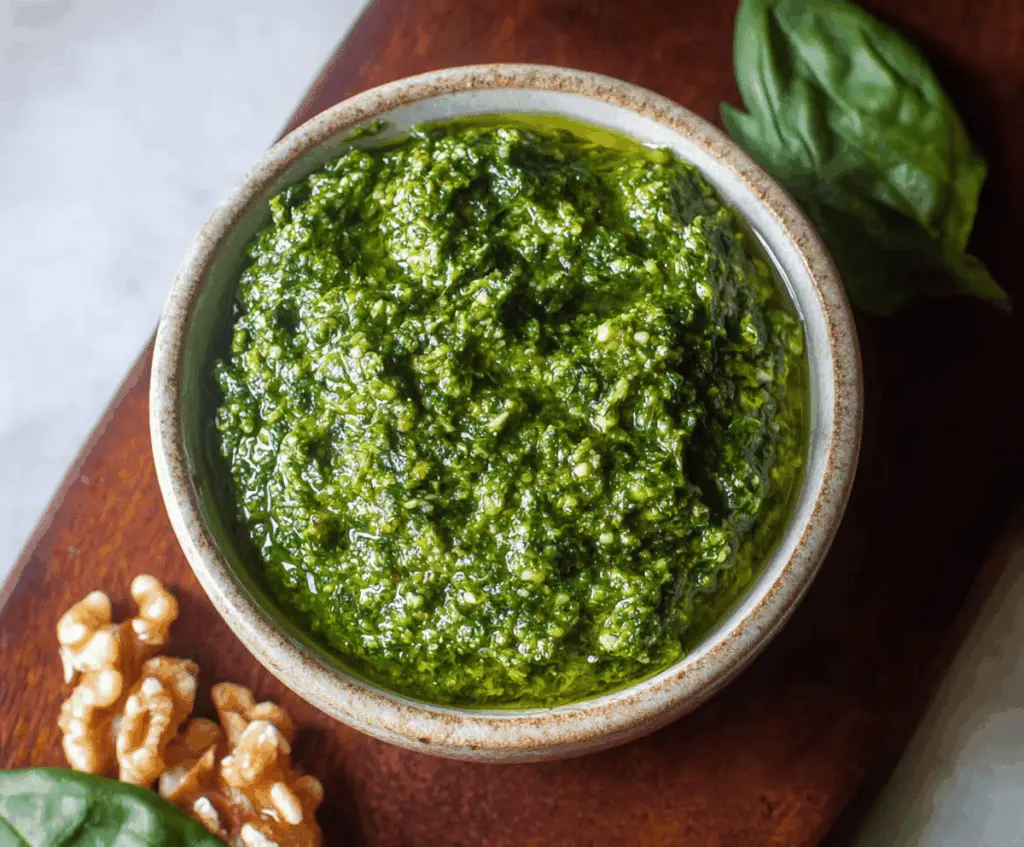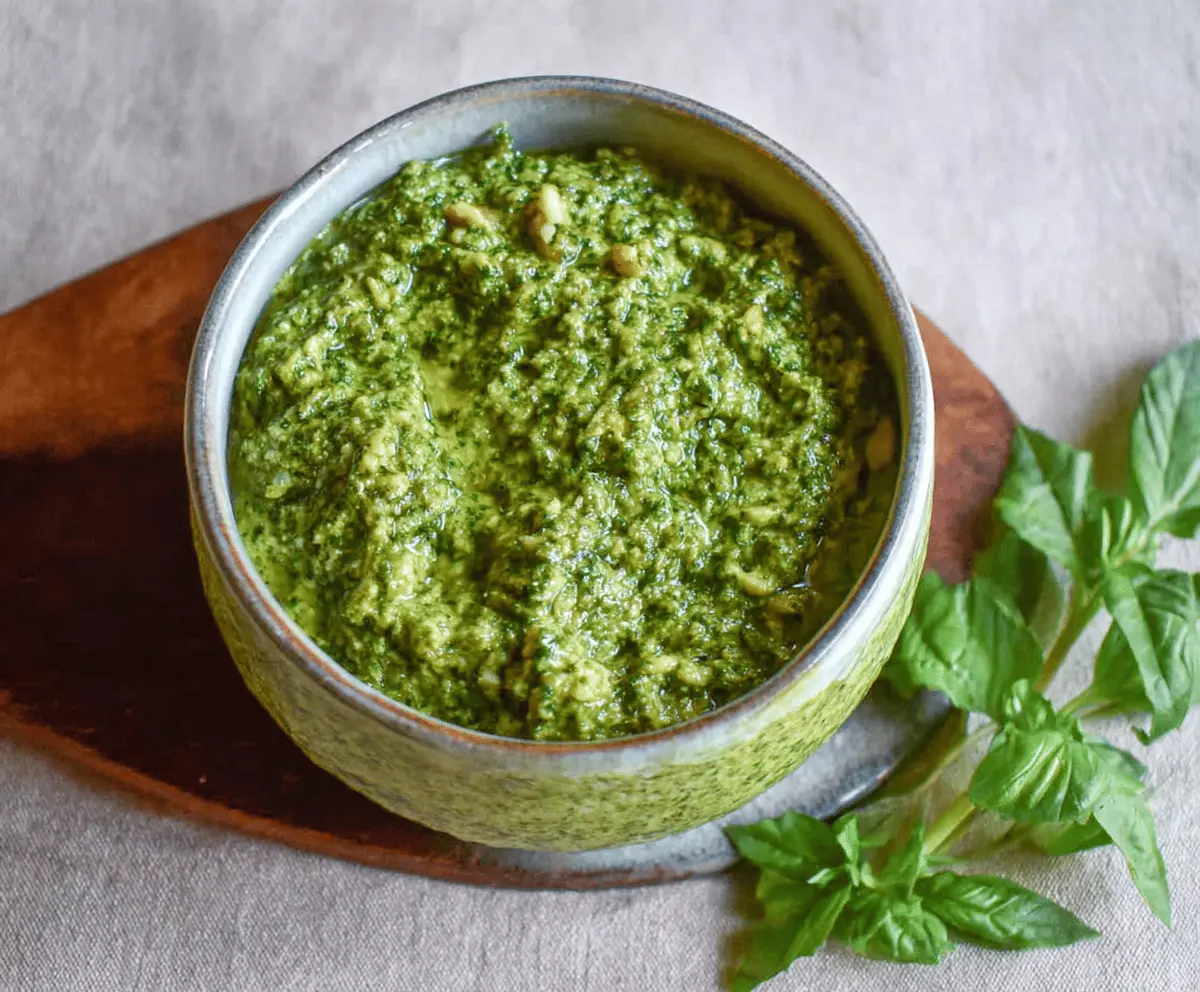
Dairy Free Pesto
This Dairy Free Pesto is a fresh and vibrant sauce that brings together basil, garlic, nuts, and a good splash of olive oil, all blended into a smooth, bright green…
Tip: save now, cook later.This Dairy Free Pesto is a fresh and vibrant sauce that brings together basil, garlic, nuts, and a good splash of olive oil, all blended into a smooth, bright green pesto without any cheese. It’s perfect for anyone avoiding dairy but still wanting that classic, herby kick you expect from traditional pesto. The nuts add a lovely richness, and the garlic gives it just the right punch.
I love making this pesto because it’s so easy to whip up and really versatile. I usually keep a jar in the fridge ready to brighten up a quick pasta, brush on grilled veggies, or even mix into salad dressings. Plus, it’s a great way to add some green goodness to my meals, and I feel good sharing it with friends who are dairy-free in a way that doesn’t compromise on flavor.
One of my favorite ways to enjoy this dairy free pesto is stirred into warm pasta with a handful of cherry tomatoes on top. It’s simple, fresh, and comforting. If you’re ever in a rush but want something tasty, this pesto will be your new go-to—it’s like a little burst of sunshine in every bite.

Key Ingredients & Substitutions
Basil: Fresh basil is the star here for that bright, herby flavor. Make sure to dry the leaves well to keep your pesto thick, not watery. If you can’t find basil, try fresh spinach or arugula—they give a different but nice taste.
Walnuts: Walnuts add a gentle richness and texture. Pine nuts are classic but pricier. You can also use almonds or cashews for a creamier pesto. For nut allergies, try sunflower seeds or omit nuts altogether and add a little extra olive oil.
Garlic: Fresh garlic is key for that punch. If you want a milder flavor, reduce the cloves. Roasted garlic can add a sweeter, softer taste if you prefer something gentler.
Olive Oil: Use extra virgin olive oil for the best flavor. It helps blend everything smoothly and adds a lovely richness. If you want a lighter oil, you can mix in some avocado oil, but the flavor will change slightly.
Lemon Juice: Lemon juice brightens and balances the flavors, replacing the tang of cheese usually found in pesto. Freshly squeezed is best, but bottled lemon juice works in a pinch.
How Do You Get the Perfect Pesto Texture Without Cheese?
A common challenge is achieving pesto that’s creamy and smooth without the help of cheese. Here’s how to nail it:
- Pulse, Don’t Overblend: Use your food processor in short bursts to keep some texture. Overblending can make the pesto too thin or oily.
- Slowly Add Oil: Drizzle in olive oil gradually to control thickness. Add just enough for a silky texture but not so much that the pesto separates.
- Dry Ingredients: Pat basil dry completely; extra water thins the sauce.
- Balance with Lemon: Lemon juice adds acidity that mimics cheese tanginess, enhancing the flavor while keeping it dairy-free.
- Adjust Nuts: Use nuts with natural creaminess like walnuts or cashews and activate their oils by pulsing well.
Equipment You’ll Need
- Food processor or blender – makes mixing the basil, nuts, and oil quick and easy for a smooth texture.
- Measuring cups and spoons – helps you add the right amounts of oil, lemon juice, and seasonings.
- Spatula – great for scraping down the sides of your processor to blend everything evenly.
- Small bowl or jar – perfect for storing the pesto and keeping it fresh in the fridge.
Flavor Variations & Add-Ins
- Swap walnuts for cashews for a creamier pesto that feels extra rich and smooth.
- Add a handful of spinach or kale with the basil to boost nutrients and add a milder green flavor.
- Add red pepper flakes for a little heat when you want a spicy kick.
- Mix in nutritional yeast to get a cheesy flavor without dairy, great if you want a familiar pesto taste.
How to Make Dairy Free Pesto?
Ingredients You’ll Need:
- 2 cups fresh basil leaves, packed
- ½ cup walnuts (or pine nuts)
- 3 cloves garlic
- ½ cup extra virgin olive oil
- 1 tablespoon lemon juice (freshly squeezed)
- ¼ teaspoon salt (adjust to taste)
- ¼ teaspoon black pepper (optional)
How Much Time Will You Need?
This pesto takes about 10 minutes to prepare from start to finish. You’ll spend just a few minutes rinsing and drying your basil leaves and then blending everything together. Letting it sit for 15 minutes before serving helps the flavors come together beautifully, but this step is optional if you’re in a hurry.
Step-by-Step Instructions:
1. Prepare the Basil Leaves:
Start by rinsing your fresh basil leaves under cold water, then pat them completely dry with a clean towel or paper towels. Removing excess moisture is important so your pesto isn’t watery.
2. Blend the Nuts, Basil, and Garlic:
Put the basil leaves, walnuts, and garlic cloves in a food processor. Pulse several times until the mixture is roughly chopped and combines well.
3. Add Olive Oil and Seasonings:
With the food processor running, slowly drizzle in the extra virgin olive oil until the pesto forms a smooth but slightly chunky sauce. Add lemon juice, salt, and black pepper. Pulse again to mix everything evenly.
4. Taste and Adjust:
Give your pesto a taste and add more salt, lemon juice, or olive oil if needed to reach your preferred flavor and texture.
5. Rest and Store:
Transfer the pesto to a small bowl or jar. If you have time, let it rest for at least 15 minutes to allow the flavors to meld. Serve immediately, or cover and store in the fridge for up to 5 days. To keep it fresh and vibrant, pour a thin layer of olive oil on top before sealing.
Can I Use Other Nuts Instead of Walnuts?
Absolutely! Pine nuts are traditional, but cashews, almonds, or even sunflower seeds work well. Just keep in mind that different nuts will slightly change the flavor and texture.
How Should I Store Leftover Pesto?
Store leftover pesto in an airtight container in the refrigerator for up to 5 days. To prevent browning, pour a thin layer of olive oil over the surface before sealing.
Can I Freeze Dairy Free Pesto?
Yes, pesto freezes beautifully! Portion it into ice cube trays, freeze, then transfer to a freezer bag. Thaw in the fridge overnight or stir frozen cubes directly into hot pasta or sauces.
Is There a Substitute for Fresh Basil?
If you don’t have fresh basil, spinach or arugula can work as alternatives. They’ll change the flavor slightly but still make a tasty, vibrant pesto.
